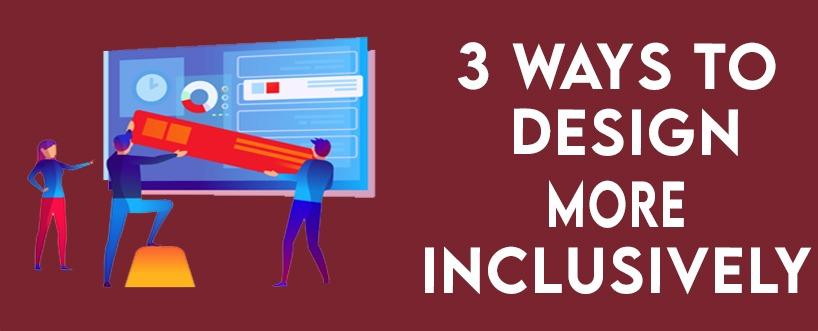3 WAYS TO DESIGN MORE INCLUSIVELY
Comprehensive design is regularly confused with accessibility, or even utilized as a compatible term, which is a decent sign that most designers don't have a clue what it implies.
Accessibility is a cycle that looks to moderate issues in a design that isn't adequately general; comprehensive design expands the all-inclusiveness of the design.
Accessibility is worried about evenhanded, quantifiable upgrades. It's a UI concern. Comprehensive design is emotional, harder to quantify, and is a UX concern. By designing inclusively, we stretch out our designs to the largest conceivable client gathering and add to a superior society. The following are three different ways to begin.
1. You're the Edge Case
At the point when we utilize the expression "edge case," what we're alluding to is a minority experience, a method of utilizing our design that is extraordinary or unmistakable from our own assumptions.
On the off chance that we start from the position that we are the one conflicted in relation to the design, that a great many people won't think or go about as we do, then, at that point, we're disposing of thousands of one-sided choices concerning how our design ought to be.
DRAW FROM LIFE
Draw from genuine however much as could be expected. That implies leaving personas — which are by definition under-delegate and every now and again stacked with the inclination — and drawing in with real clients. In particular, it implies making a stride back and opening your eyes.
2. Quit Making Inclusive Design Part of Your Practice
Comprehensive design can't be a piece of your training; it's a widely inclusive demeanor. Your design practice should be comprehensive. In any event, it ought to seek to be…
As people, we are one-sided—we all. The justification behind that will be that predisposition — be it bigotry, sexism, patriotism, homophobia, or whatever else — is social. Also, we as a whole exist inside society. All of us are besieged with data that builds up those predispositions consistently.
Acknowledge that you have predispositions and that your inclinations will pull your design work away from the comprehensive arrangement you yearn for. However, similarly, acknowledge that by recognizing your predispositions you're restricting the impact they have over your dynamic.
3. Design Flexibility Into Everything
At the point when we design a site or application, we watch out for storehouse certain attributes into one. Somebody who is outwardly weakened is blessed to receive the equivalent 'arrangement' as somebody who is visually impaired, despite the fact that visual impedance can go from screen reflections on a radiant day to somebody who was brought into the world without optic nerves.
There are individuals who have lost their sight through degeneration or mishap and will actually want to make visual associations dependent on recalled visuals. Others have seen nothing and their cognizant mental cycle isn't metaphorical in any way.
To oblige the full array of potential collaborations with our design, we need to design to a scale, not with outright qualities. This implies pondering set tones and estimates and more as far as differentiation and scale.
If you are looking for a trusted Web Designing Company in United States, Web Design Agency in United States & Website Design Company in United States to enhance your social presence, Please feel free to call us +91 987-16-888-00 or email us at sales@firstpointwebdesign.com and we'll be more than happy to assist!
Contact us for a free website designing consultation and quote.
Hopefully, these tips will help you. Give us, Web Designing Company in United States, shout back, if you use them or have some other ideas to share.
Registered
Office
www.firstpointcreations.com
G - 55, Masjid Moth, Greater Kailash - III, New Delhi - 110048, INDIA
business@firstpointcreations.com,
Call
Now: +91-+91-9871688800,




.jpg)

.png)
















